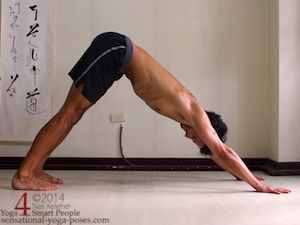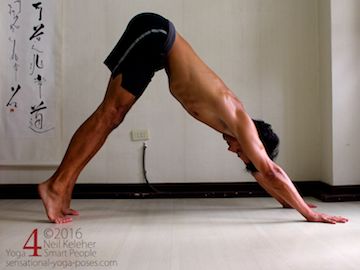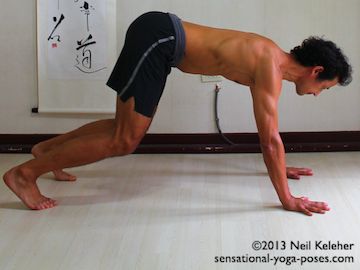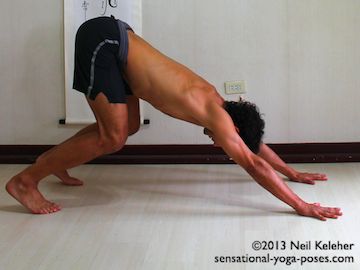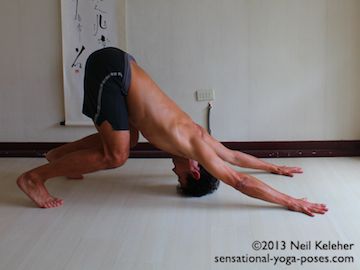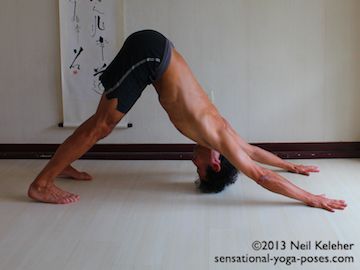Getting Your Heels Down
If you are having trouble getting your heels down to the floor in downward facing dog, one simple solution is to focus on lifting the fronts of your feet.
(If you were sitting with your legs straight in front the equivalent action could be pulling your toes and forefeet back towards you.)
An exercise that may help is to lift your heels with knees straight while inhaling then push your heels down and lift the fronts of your feet while exhaling. Or simply hold for a few breaths with heels lifted then sink your heels down for a few breaths and focus on pull up on the fronts of the feet.
In both cases you can keep your knees straight.
Why Lift the Fronts of Your Feet?
If you focus on lifting the fronts of your feet in Downward Dog you activate the muscles at the front of your shins (tibialis anterior.)
In downward dog it may be hard to get your weight far enough back that you can use body weight to press your heels down.
So you'll have to use opposing muscles to stretch your calve muscles instead. This takes advantage of something called mutual inhibition. This is where if one set of muscles is activated to move a joint in a particular direction then muscles that oppose that movement will relax to allow that movement.
In the case of lifting the fronts of the feet, the intended action is to bend the ankles forwards.
Since the calve muscles normally resist this motion they then relax to let it happen.
What To Do with your Shoulders?
Even before you get to pushing your heels down it may be helpful to practice using your shoulders in downward dog. The idea is to use the shoulders to push the ribcage up and back away from the hands.
If you were sitting or standing, the action would be that of lifting the shoulders with the arms over head.
This uses the upper and middle fibers of the trapezius muscle to slide the shoulder blades up the back towards the head.
Depending on whether or not you also spread the shoulder blades (protraction) you may also be using the serratus anterior muscle.
(For more about moving and stabilizing the scapula in preparation for down dog and other inverted yoga poses read the scapular awareness article.)
So that you can focus on using your shoulders, keep your knees bent for this downward dog exercise.
Knees Bent Downward Dog
Start with your hands shoulder width apart, elbows straight and fingers spread. Bend your knees and lift your heels.
- To begin with move your torso forwards so that your shoulders are over or just behind your wrists (first picture above.)
- Use your hands as if to push the floor forwards, away from you so that your ribcage moves up and back, away from your hands.
- Return to the starting position and repeat.
As you repeat the exercise first focus on feeling your hands pressing forwards when you press your ribcage back. Then notice how your ribcage moves relative to your shoulder blades (or notice your shoulders moving relative to your ribcage.)
Once you can feel your shoulders activating you could then additionally focus on:
- creating space between your ribs, and
- between your ribcage and pelvis
The idea of both actions is to make your spine feel long. Additionally you could also pull your ears away from your ribcage so that you neck feels long also.
Heels Lifted (Knees Straight) Downward Facing Dog
After you've gotten used to the first exercise, take a rest if you need to.
Then do the same exercise but this time straighten your knees and lift your heels as you push your ribcage and hips back and up. Then relax and return to the starting position.
- Make your legs feel long and lift your heels as high as possible.
In this version of downward dog do continue to use your shoulders to push your ribcage back and up. Also do continue to make your spine feel long.
But additionally make your legs feel long also.
For both exercises you can inhale as you push back and exhale as you relax forwards.
One additional action you can focus on is making the backs of your knees feel "open."
When doing so, ideally the muscles at the fronts of your thighs (the "quadriceps" will activate.)
Sinking the Heels, Using Shoulders and Lifting Fronts of Feet
For the next exercise, as you push your ribcage back and up using your shoulders, straighten the knees and push the heels down.
For this exercise first focus on your shoulders and spine. Use your shoulders to again push your ribcage back and as you do so make your spine feel long.
Then focus on opening the backs of the knees so that the quadriceps activate. Then to get the heels down focus on lifting (or pulling upwards on) the fronts of the feet. Then lift the heels, bend the knees and move the shoulders forwards again and repeat.
Holding space while holding downward dog
After a few sessions of practicing the above variations of downwards facing dog you may find that you can simply hold downward dog while keeping your shoulders open, your spine long, the backs of the knees open and your heels reaching downwards.
When holding downward dog you could allow your spine to lengthen slightly as you inhale and allow it to relax and shorten while exhaling.
Or you can work at keeping your spine feeling long.
In this case try holding the lower belly in and breath into your upper belly and the ribcage.
Sinking the Shoulders in Downward Facing Dog
One question you may have is whether or not it is okay to sink the shoulders towards the floor in downward facing dog, as if trying to move the arms rearwards, relative to the ribcage.
I'd suggest first learning to use your shoulders to push your ribcage back away from your hands so that your arms and torso form one straight line.
In this case your trapezius muscles are active, helping to slide the shoulder blades up the back towards the head.
From there, you can then work on sinking the shoulders by activating the deltoids, the shoulder muscles.
Using the deltoids, (while keeping the ribcage pushing back away from your hands), you'll be doing an active stretch, using opposing muscles to drive the stretch.
While doing so keep the arms and torso feeling long. You may find that you are activating the upper arm muscles as well as the shoulder muscles.
Rather than suddenly trying to activate your shoulders, work at doing it slowly and smoothly and notice how your shoulder joints feel while you are doing this action. If there is any sort of ache, you either need to change the way that you do it, adjusting shoulder blade position and/or muscle action, or simply not do it.
Note to start of with try this action with knees bend then with knees straight.
This action can be a great way to prepare for backbending the shoulders while in wheel pose.
However the main difference between using the shoulders in wheel pose versus in downward dog is in that wheel pose the shoulders are working against gravity to push the ribcage up.
In downward dog, if your goal is to stretch the shoulders then it is very easy to relax the shoulders and leg the ribcage sink down.
This can lead to painful shoulders, so I would advice caution in this variation.
If your shoulders are painful after doing downward dog in this way then change the way that you do it!
Try to figure out how to active the shoulders and scapular stabilizers) or don't do it.
So even if you are sinking the shoulders in downward facing dog, do continue to work at using the shoulders to push the ribcage back, away from the hands.
Doing Downward Facing Dog with the Elbows Bent?
A variation of downward facing dog is to bend the elbows and place them on the floor with forearms parallel. The resuting pose is called Dolphin Yoga Pose.
Published: 2011 07 17
Updated: 2021 02 09
